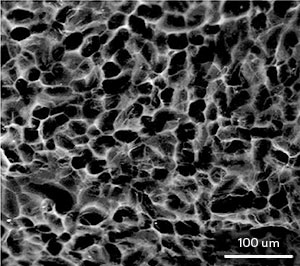| Jul 03, 2013 |
Greater anticancer potency with less risk
|
|
(Nanowerk News) Proteins and other therapeutic compounds injected directly into the blood stream tend to be broken down rapidly by the immune system. Now, researchers in Singapore have demonstrated in mice that the anticancer protein, interferon-α2a (IFN-α2a), can be delivered more effectively to liver tumors when incorporated into an injectable hydrogel ("Injectable hyaluronic acid-tyramine hydrogels incorporating interferon-α2a for liver cancer therapy").
|
 |
| A scanning electron microscope image of the injectable hydrogel containing interferon-α2a.
|
|
Motoichi Kurisawa and co-workers at the A*STAR Institute of Bioengineering and Nanotechnology say their work indicates that hydrogels can protect therapeutic proteins from attack while releasing them in a controlled manner. As a result, more of the anticancer agent accumulates in tumors, and patients are at lower risk of side effects. “Our hydrogel system can also be developed to incorporate other potent drugs, proteins or small molecule drugs to achieve controlled release of therapeutics for various diseases,” Kurisawa says.
|
|
Hydrogels first attracted the interest of medical researchers because the large amount of water they contain provides an environment that prevents proteins from denaturing or losing their shape. The injectable hydrogel developed by Kurisawa and co-workers is composed of a substance known as a hyaluronic acid–tyramine conjugate. The linkage reaction to form the gel is catalyzed by hydrogen peroxide, the level of which controls the stiffness of the gel, and horseradish peroxidase, which can tune the rate of gelation.
|
|
Kurisawa and co-workers previously demonstrated that proteins such as lysozyme and α-amylase could be incorporated and released by the hydrogel ("An injectable hyaluronic acid–tyramine hydrogel system for protein delivery"). Their more recent in vitro work with IFN- α2a showed that the gel remained unaffected after incorporating the protein, and that the protein was released via diffusion. Importantly, the IFN-α2a released from the gel could inhibit the proliferation of liver tumor cells and induce apoptosis, or ‘cell suicide’.
|
|
In live mice, the injected hydrogel delivered up to three times as much IFN-α2a to liver tumor sites compared to direct injection in solution. The hydrogel treatment was also more effective: the average size of the tumors in mice injected with the hydrogel reduced significantly, whereas those in mice injected with IFN-α2a in solution remained the same. Cells in the tumors in hydrogel-treated mice also showed a decrease in proliferation and an increase in apoptosis. In addition, the hydrogel-delivered IFN-α2a inhibited the development of nutritive blood vessels in these mice.
|
|
“We are now planning to develop another hydrogel system to enhance the half-life of therapeutic proteins in the body even more,” Kurisawa says. “And we are modifying our current hydrogel system to allow hepatitis treatment through the sustained release of interferon.”
|

